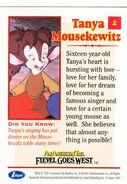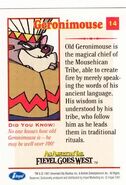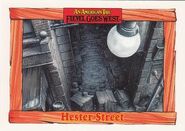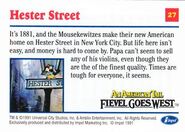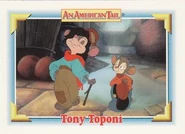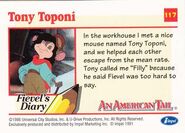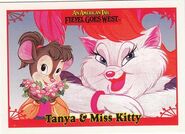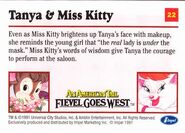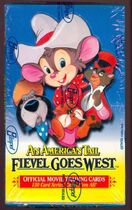
In 1991, to promote the then-upcoming film An American Tail: Fievel Goes West, the trading card company Impel released a set of 150 trading cards. These cards featured images on the front (either an actual screencap or promotional art) and canon information from both Fievel Goes West and An American Tail on the back. They were sold either in small packs of 12 or as a complete set. The subjects of the cards were as follows:
- Film plots: Not only was Fievel Goes West retold on the backs of the cards but the first film as well. The events of An American Tail are retold from Fievel's perspective in his diary.
- Character Profiles: Major characters from the first two movies are given profiles on the backs of some cards. In some cases even minor characters, such as members of the Cactus Cat Gang who are never named in the film, received cards of their own. Characters with strong friendships or relationships, such as Fievel and Tanya or Tiger and Miss Kitty, have cards talking about their relationship.
- Locations: Iconic locations such as Hester Street, The Statue of Liberty and Green River have their own cards.
- Animation Production: Some cards explained the animation process, from screenplays to storyboards and cel painting.
- Public Service Announcements: Some of the last few cards in the set have Fievel telling you to be safe when you go on adventures, choose your friends carefully, never play with a real gun, and to love your family.
For the time being, all 150 cards can be viewed on The Trading Card Database.
Trivia[]
- Evidence that Tanya was originally going to have a love interest in Fievel Goes West turns up on one of her cards. This love interest, named Willie, appears in the comic book adaptation.
- The cards state that the Mousekewitz family were living on Hester Street at the beginning of Fievel Goes West. The street appeared in the first film; the spot where Fievel climbed into a phonograph and was thrown out the window by a frightened woman.
- Tony Toponi is classified as a "missed" character on his card due to the then-upcoming sequel excludes him from his official appearance without Pat Musick’s involvement, but can only be seen as a background cameo. The character doesn’t officially return until the later DTV sequels.
- "Earless" Poultroon, Frenchy and Geronimouse are among the minor characters who had no name in the film but are given one in the cards (though Earless would later come to be known as Felonius in the television show).
- There were some errors on the cards with the dates. The Hester Street card claims the Mousekewitz family settled there in 1881, while the Statue of Liberty card claims the statue was finished in 1885 (a year too early). While the first film opens in 1885, it is Hanukkah, a holiday in December, meaning the rest of the film couldn't possibly have taken place that year.

